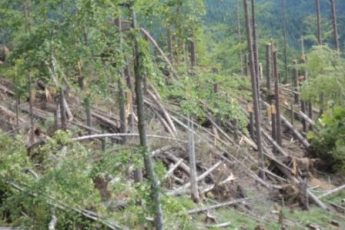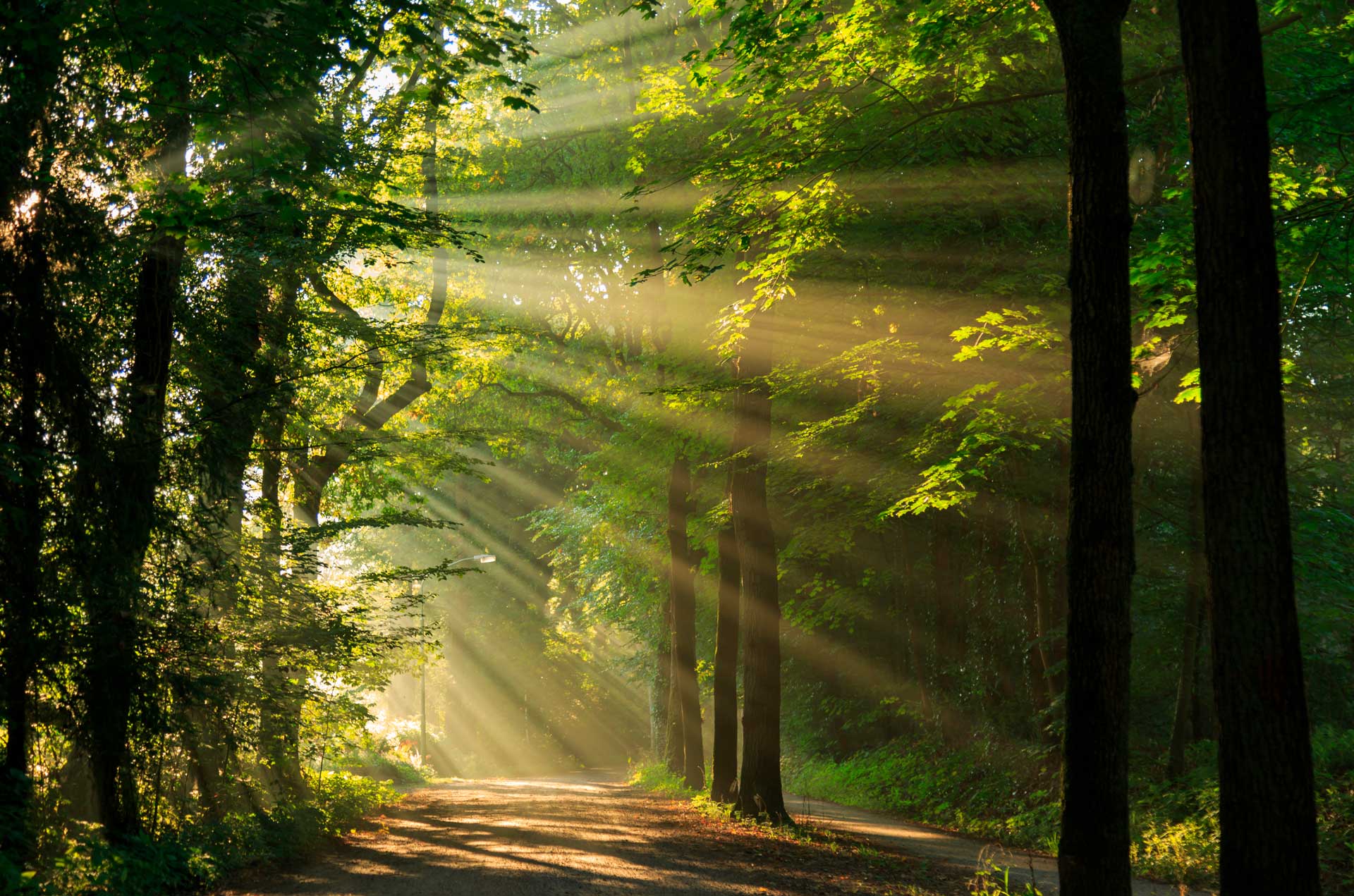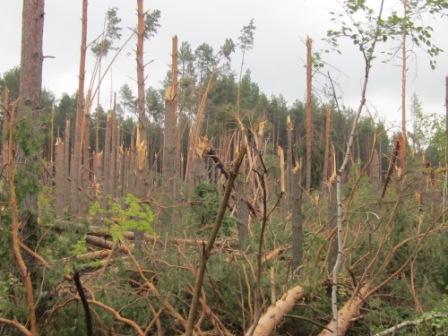
Consequences of natural boutiques in the Carpathians
One of the most important tasks of forestry is to solve the problem of restoration of indigenous wood conditions in the Carpathians, maintaining the stability of forest ecosystems, increasing their productivity, strengthening of water-security, soil-protective and anti-erosion Properties. Increased stability of plantings against wind and experience of pests and forest diseases is one of the most topical and complex complex forestry problems. Forests have always been exposed to negative effects of harmful atmospheric factors that have inflicted on and cause significant damage.
The main reason of large and frequent wind turbines, which are observed in the Carpathians now is that in the postwar years, especially in the area of spruce forests, the area of solid log cabins in some river basins in two or three times exceeded the area of settlement forest; Timber was located without consideration of the direction of prevailing hurricane winds, steep slopes, their geological structure and soils.
According to the literary data the largest wind farm was observed in the Ukrainian Carpathians in 1868, 1869, 1872, 1885, 1902, 1912, 1941, 1957, 1964, 1969, 1970, 1982, 1989 and 1992 years. In 1868-1869-р. In Transcarpathia, there was a strong hurricane, which deposed 2565 hectares of forest, and in 1886. -2302 hectares, in July 1869, 2008. -2500 hectares. Total in the Carpathians for 1868-1869. The 12.8 thousand were destroyed. Hectares of forest.

In the following period the most intensive wind farm was registered in the Ukrainian Carpathians after 1957 year. During the period 1957-1960 pp. Solid and partial wind turbines took place on the area of 520 thousand hectares, which damaged more than 21 mln. Cubic m of wood. During these years the annual volume of windproof wood with insignificant deviation constituted the calculated forest, and in 1964 exceeded it more than twice. P. A. Stands Reports on catastrophic wind turbines in Ivano-Frankivsk region for 1957-1960 years, after which the 6718.2 thousand was formed. Cu m of wind wood, and also due to the destruction, another 600 thousand Cu m Sustoiv. The author notes that since 1959 year, the annual formation of wind turbines does not terminate till today. The reasons are the same. In some years, depending on the strength of the winds, they are formed more in others-less. In December 1989 and February 1990 the winds, whose speed reached 30-40 m/C only in one Ivano-Frankivsk region, were rolled out 2.4 mln. Cubic m of wood.
During 1998-2004, 2006. Mass catastrophic windshafts in Ivano-Frankivsk region were not observed. However, the total area of forests of the region, which suffered the devastating influence of natural phenomena of the local character is sufficiently significant and is 3119 hectares. The most massive wind and storm were observed in the benefit (625 hectares), Osmolovitsky (478 hectares) and Nadvirna (294 hectares) of state forestry enterprises.
According to data of Zakarpattia Regional Department of Forestry and Hunting economy in 1981-1990-р. Wind turbines damaged in Transcarpathia 2651.4 thousand Cubic m of wood.
It is identical to the problem with the wind shaft and Bukovina. Here in the last 20 years of wind turbines and the shearmen were covered with an area of 150 thousand. hectares, including solid wind turbines-about 3 thousand. Ha.
In the forests of Europe, the situation with regard to wind ownership is the same as in Ukraine. In Poland in the early 70, the wind was damaged by 40 million cubic meters of wood. In north-western Europe in November 1972, a hurricane, which was named Hurricane century, had approximately 25 million cubic meters of wood. In February and March of the month of 1999 was a wave of two more hurricanes, a pity from which several times exceeded the volume of previous ones.
The main factors that cause damage to Smereka in the Carpathians are abiotic factors: fluctuations in solar activity, wind and atmospheric precipitation, ground cover, and decisive role in this is the exposition of slopes. That is, the more wind-shock is a slope, the greater the pressure of the air on the tree and a greater probability of damage to the plantations.
The influence of elevation of the terrain above sea level is also essential. Directly this influence is evident in the fact that with increase of height the amount of precipitation increases and correspondingly decreases the temperature of air. In the Ukrainian Carpathians wind and storm are most often observed within the heights of 700-1100 (1200) m n. M., which is due to increase here the number of days with strong winds as a result of more drastic fluctuations in atmospheric pressure, increasing velocity Dangerous winds, as well as plenty of precipitations.
The peculiarity of the Carpathian soils is low water resistance of unpaved aggregates at very low water permeability, as a result of rapid rehydration of soil reduces the force of adhesion of the root system with soil.
In the group of biotic factors that determine the wind-hazards of the situation, the leading place is occupied by the peculiarities of the lissidelsational indicators of tree-states. There are especially Windrolls, which were formed as a result of carrying out of solid runes. The dependence of the windshafts from the age of plantings is especially clear. The critical of the wind resistance is age 60-80 years. Wind turbines can only occur when trees in the tree have a corresponding height. Therefore, the wind is more threatening senior and high-bonted woodmen.
Most of these wind farms were observed in spruce forest. 72% of the total volume of the windproof wood fell to this breed. The proportion of wind wood of fir-tree was 13%, Beech-12%, other breeds-only 3%.
This situation is explained by biological features of Smereka, in particular the peculiarity of the structure of its roots: at a distance of 1-1, 5 m from the trunk thickness of the root decreases three four times, it is branched out on a large number of anchor roots of small thickness.
By the degree of wind-hazardous wood species are located in the following order: Smereka, Spruce White, aspen, alder Black, oak ordinary, beech forest, Birch borodavčasta, oak Northern, pine Ordinary, hornbeam ordinary feature of all woody breeds is that The greatest wind-hazardous danger is characterized by pure planting (from one breed). With a decrease in the proportion of each breed resistance to the windrises of the tree is increased. For Smereka It is observed with a decrease of its participation in 7-9 units, for Beech-4-6, a decrease in the proportion of pine trees below 9 does not affect the increase of wind resistance. Depending on the types of habitat conditions, wind-resistant breeds are considered: in the Sabbath-Birch, pine, cedar, Carpathian, larch, European, cherry; In Susmerchany-fir, beech, yasvir, larch, cherry; In Spruce-fir, beech, yasvir, Ash, Douglas.
Proper mixing breeds-one of the important conditions of good growth and the state of cultures. It is recommended to use such types of mixing, as Kulisny, Kulisno-lankovy or small groups of size 5×5 and 10×10 m or jerky stripes.
In the development of the schemes of wind-resistant crops should be considered that the resistance of the crowns of spruce and fir almost single, crowns Beech-at 20-30% more than in Smereka, but in the undeciduous state, it drops sharply and is 20% of the original, while in the conifers liquefied wood crowns Does not affect their wind resistance. Therefore, in early spring, late autumn and winter beech at solitary and dusty place on the square in the mixed planting can not be sufficient barrier. Only a vague placement of hardwoods contributes to an increase in wind resistance of wood state.
The measures of prevention of windproof are recommended for taking into account the sanitary condition of the plantings.
In the weakened, moderately affected spruce-trees, it is necessary to promptly carry out the selective sanitary chopping with simultaneous assistance to the natural restoration of wood, which correspond to the edfoclimatic conditions of the territory. In Progalinah, which are formed in the process of selective runes, it is necessary to create a tent culture or to sow seeds of beech, fir, birch, gray alder and other breeds that are less vulnerable to negative effects of root pathogens.
In healthy spruce forests, which grow on high-altitude marks, above 800 m n. M., where the process of injection is not gained mass distribution, it is necessary to reform the pure singular tree of smereka in a different, mixed plantations with the faded vertical Structure. It is necessary to orient on an existing natural renewal with the obligatory complement of the necessary hardwood.
Having analyzed the information on the problem of windshafts in the mountain forests of the Ukrainian Carpathians can be noted the following:
- Damage to forest arrays The wind is observed almost annually, reaching for some years of catastrophic level;
- The largest wind farm is observed in the pure one-to-one of 60-80 years of age within the heights of 700-1100 m above sea level;
- Natural rehabilitation of damaged forest ranges takes place for a long period of time;
- Artificial rehabilitation is carried out for a short period of time, but in quite difficult forest plant conditions (deformed ground cover and highly cluttered area). The main requirement of cultivated breeds is to ensure optimum participation of wind-resistant, especially hardwood;
- The level of damage to the wind plantings is largely dependent on their species, density and many other high-level indicators;
The “Ivano-Frankivsk Forest protection” Company constantly conducts monitoring of damaged plantings. Thus, at the end of June this year, due to the damage of the element (strong gusts of wind) in Ivano-Frankivsk and Zakarpattia regions, there are more than 700 hectares of damaged plantings, including solid wind-trees in the area of 220 hectares. The largest area of wind-rollers was formed in SE «Osmoloki forestry» (about 200 hectares, including Solid-80 hectares) And in the SE «Mokyriansky forestry» (150 hectares, including Solid – 60 hectares).
All damaged areas are taken into account, where the urgent conduct of appropriate sanitary-and-health measures is projected.
by materials
“Ivano-Frankivsk forest protection” DSLP




